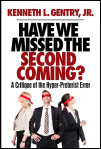THE SONS OF GOD IN GENESIS 6
PMW 2023-085 by Kenneth L. Gentry, Jr.
The episode occurring in Genesis 6:1–4 is quite difficult to interpret and has been the subject of much debate. Though there are several interpretations of this passage, historically two views have dominated the debate: (1) the angelic offspring view and (2) the human seed-line view.
Though the seed-line view is the traditional Christian understanding, perhaps the oldest view in extra-biblical antiquity is the angel-human interpretation. It is found as far back as 200 B.C. in the non-biblical book of 1 Enoch (6:11–7:6) as well as in the first-century book by Josephus called Antiquities (1:3:1). This view holds that fallen angels came down to earth and engaged in sexual relations with women who then bore giants as their offspring.
The seed-line view holds that the godly line of Seth (4:25) that has been the focus of Genesis since Genesis 5:3 is beginning to intermarry with unbelieving women (“whomever they chose” without reference to their faith. These women would be largely represented by the Cainite line (4:17ff). This appears to be the proper interpretation due to its fitting the context and avoiding bizarre results.
THE ANGEL VIEW
The angel interpretation is based on the following main lines of evidence: (1) The “sons of God” is a reference to angels, as we can see in Job 1:6; 2:1; 38:7. (2) The word “Nephilim” (6:4) signifies giants, which may be the case in Num. 13:33. (3) Passages such as 1 Peter 3:19–20; 2 Peter 2:4; and Jude 6–7 support this interpretation.
Nevertheless, the evidence for this angelic interpretation is unpersuasive for the following reasons:
(1) The concept “sons of God” can certainly mean angels, but it can also refer to God’s people (Exo. 13:15; Jer. 3:19; Gal. 3:26; see further discussion below). Besides, Genesis has not mentioned angels to this point, so that their sudden appearance would be surprising. But in the final analysis, the beings in Genesis 6 could not be fallen angels and associates of Satan, for they would not be called “sons of God.”
Have We Missed the Second Coming:
A Critique of the Hyper-preterist Error
by Ken Gentry
This book offers a brief introduction, summary, and critique of Hyper-preterism. Don’t let your church and Christian friends be blindfolded to this new error. To be forewarned is to be forearmed.
For more Christian educational materials: www.KennethGentry.com
(2) The word “Nephilim” (a rare term occurring only three times in Scripture) literally means “fallen ones” and can therefore apply to notorious sinners. Its verbal form (“fall”) occurs scores of times suggesting its ethical meaning.
(3) The New Testament passages do not mention any cohabitation of angels with women, and certainly not their marrying them. 1 Peter 3:19 does not mention angels, but is referring to the evil men in Noah’s day. The other two New Testament passages refer back to the original fall of angels, not something that occurs later in Genesis 6.
(4) The fact of giants being mentioned in the context of the Nephilim does not help the argument. We see other giants in the Bible, such as the Emim (Deut. 2:10–11), the Zamzummim (Deut. 2:20–21), king Og of Bashan (Deut. 3:11), Goliath (1 Sam. 17:4–7), and more, yet no one claims that they were the offspring of angels.
The following additional problems arise for the angelic view: (1) Jesus teaches that angels do not marry (Matt. 22:30; Mark 12:25), though Genesis 6:2 speaks of these “sons of God” taking wives (cp. 4:19; 11:29; 12:19; 31:50). Genesis 6 is not speaking of fornication, but of settled marriage. Only in this one difficult passage in Scripture do we have anything suggesting angels marrying humans. (2) Angels are a different order of being in that they are spiritual beings (Heb. 1:14). When they assumed visible, tangible form they would do so only for a time and surely would not possess human DNA allowing for procreation while dwelling on the earth. (3) In Genesis 6 God’s judgment is directed against men, not the alleged angels (6:3, 5–6, 13).
THE SEED-LINE VIEW
The proper interpretation sees in this episode the inter-marrying of the godly line of Seth with unbelievers, particularly represented by the depraved line of Cain. This fits perfectly with the contextual flow of Genesis to this point. Genesis is structured by toledoths (“genealogies”) showing its interest in genealogical progress (see 2:4 Note). In fact, the two genealogies surrounding Genesis 6 are found in Genesis 5 and Genesis 10–11. They are specifically designed to link Adam to Noah, then Noah to Abram whose genealogical offspring will dominate Genesis from chapters 12 to 50.

As It Is Written: The Genesis Account Literal or Literary?
Book by Ken Gentry
Presents the exegetical evidence for Six-day Creation and against the Framework Hypothesis. Strong presentation and rebuttal to the Framework Hypothesis, while demonstrating and defending the Six-day Creation interpretation.
See more study materials at: www.KennethGentry.com
The Cainite line begins with Cain whom God rejects due to his sinful attitude (4:5). He murders his brother (4:8), lies to God (4:9), then is “cursed from the ground” (4:11), and finally “went out from the presence of the LORD” (4:16). This line is traced to and concludes with Lamech who boasts of murdering a man (4:23–24).
After introducing Cain’s evil line the context quickly shifts to Seth’s line, which is when “men begin to call upon the name of the LORD” (4:25–26). Seth’s godly line (5:3ff) not only flows from worshipful men (4:25) but includes long-lived men (cp. 5:5, 8, 11), whereas the ages of Cain’s descendants are not mentioned. Among these godly men we find not only Seth and Enosh who publicly worship God (5:6–9), but also Enoch who “walked with God” and was taken into heaven (5:22, 24) and Noah (5:29) who “found favor in the eyes of the LORD” (6:8).
Genesis is tracing the redemptive line that leads to Abram (11:2) from whom will come the Savior of the world Jesus Christ (Matt. 1:1; Acts 3:20–26; Gal. 3:16; Heb. 2:14–16; cp. John 8:56). The Genesis narrative shows the difficulties facing the seed-line, with Abraham (17:17–19; 21:5), Isaac (24:1–4; 25:12), and Jacob (28:1–2; 29:21–25; 30:1) having trouble continuing it.
Now in Genesis 6 the godly line of Seth (“the sons of God”) begins intermarrying with the godless Cainites. Those women are simply deemed “daughters of men” without any spiritual or ethical traits mentioned. The “sons of God” here speaks of God’s people, as does the concept in Deut. 14:1; 32:5; Psa. 73:15; and Hos. 1:10 (the word “sons” [ben] occur in the Hebrew of these verses).
Previously in Seth’s line we see “sons and daughters” appearing (5:4, 17, 10, 13, 16, 19, 22, 26). But just as Eve was tempted to take the forbidden fruit in Eden partly because it “was a delight to the eyes” (3:6), so here the Sethites begin choosing women simply because they were “beautiful.” They took “whomever they chose” on this external basis (6:2). The redemptive line is being corrupted; its final issue hangs in the balance. Ultimately only Noah and his family will remain in the godly seed line, leading God to destroy the world (Gen. 6:5–8, 13–18; 9:1; cp. Heb. 11:7; 1 Pet. 3:20; 2 Pet. 2:5).
In Scripture God wants his people to avoid marrying outside the faith community (Gen. 27:46; 28:1ff; Exo. 34:16; Deut. 7:3–6; Josh. 23:12; 2 Cor. 6:14). This is so serious an obligation that it leads Ezra to command the men of Israel to divorce their non-Jewish wives when they return from exile to the land (Ezra 9:2; 10:3, 10–19).
Kenneth L. Gentry Jr.'s Blog
- Kenneth L. Gentry Jr.'s profile
- 85 followers



